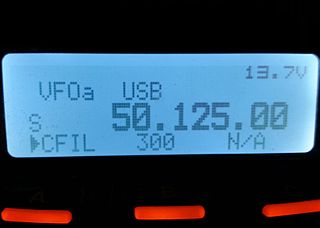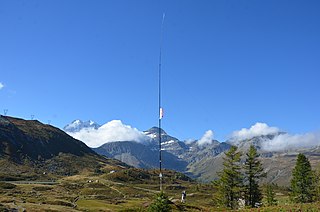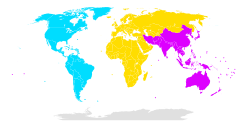The International Telecommunication Union uses an internationally agreed system for classifying radio frequency signals. Each type of radio emission is classified according to its bandwidth, method of modulation, nature of the modulating signal, and type of information transmitted on the carrier signal. It is based on characteristics of the signal, not on the transmitter used.
The 33-centimeter or 900 MHz band is a portion of the UHF radio spectrum internationally allocated to amateur radio on a secondary basis. It ranges from 902 to 928 MHz and is unique to ITU Region 2 (Americas). It is primarily used for very local communications as opposed to bands lower in frequency. However, very high antennas with high gain have shown 33 centimeters can provide good long-range communications almost equal to systems on lower frequencies such as the 70 centimeter band. The band is also used by industrial, scientific, and medical (ISM) equipment, as well as low-powered unlicensed devices. Amateur stations must accept harmful interference caused by ISM users but may receive protection from unlicensed devices.

The 6-meter band is the lowest portion of the very high frequency (VHF) radio spectrum internationally allocated to amateur radio use. The term refers to the average signal wavelength of 6 meters.
160-meter band refers to the band of radio frequencies between 1.8 and 2 MHz, just above the medium wave broadcast band. For many decades the lowest radio frequency band allocated for use by amateur radio, before the adoption, at the beginning of the 21st century in most countries, of the 630- and 2200-meter bands. Amateur operators often refer to 160 meters as the Top Band It is also sometimes nicknamed the "Gentleman's Band" in contrast to the often-freewheeling activity in the 80-, 40- and 20-meter bands.
The 80 meter or 3.5 MHz band is a span of radio frequencies allocated for amateur use, from 3.5–4.0 MHz in North and South America ; generally 3.5–3.8 MHz in Europe, Africa, and northern Asia (Region 1); and 3.5–3.9 MHz in south and east Asia and the eastern Pacific (Region 3). The upper portion of the band, which is usually used for phone (voice), is sometimes referred to as 75 meters; however, in Europe, "75 m" is used to name an overlapping shortwave broadcast band between 3.9–4.0 MHz used by a number of national radio services.
Shortwave bands are frequency allocations for use within the shortwave radio spectrum. Radio waves in these frequency ranges can be used for very long distance (transcontinental) communication because they can reflect off layers of charged particles in the ionosphere and return to Earth beyond the horizon, a mechanism called skywave or “skip” propagation. They are allocated by the ITU for radio services such as maritime communications, international shortwave broadcasting and worldwide amateur radio. The bands are conventionally named by their wavelength in metres, for example the ‘20 meter band’. Radio propagation and possible communication distances vary depending on the time of day, the season and the level of solar activity.

The 40-meter or 7-MHz band is an amateur radio frequency band, spanning 7.000-7.300 MHz in ITU Region 2, and 7.000-7.200 MHz in Regions 1 & 3. It is allocated to radio amateurs worldwide on a primary basis; however, only 7.000-7.200 MHz is exclusively allocated to amateur radio worldwide. Shortwave broadcasters and land mobile users also have primary allocations in some countries, and amateur stations must share the band with these users.
The 10-meter band is a portion of the shortwave radio spectrum internationally allocated to amateur radio and amateur satellite use on a primary basis. The band consists of frequencies stretching from 28.000 to 29.700 MHz.

The 15-meter band is an amateur radio frequency band spanning the shortwave spectrum from 21 to 21.45 MHz. The band is suitable for amateur long-distance communications, and such use is permitted in nearly all countries.

The 60-meter band or 5MHz band is a relatively new amateur radio allocation. First introduced in 2002, it was originally available in only a few countries, including the United States, United Kingdom, Norway, Finland, Denmark, Ireland and Iceland. Several decades in use, an increasing proportion of countries' telecommunications administrations – together with their government and military users – have permitted Amateur Radio operation in the 5MHz area on a short or longer-term basis, ranging from discrete channels to a frequency band allocation.
Amateur radio frequency allocation is done by national telecommunication authorities. Globally, the International Telecommunication Union (ITU) oversees how much radio spectrum is set aside for amateur radio transmissions. Individual amateur stations are free to use any frequency within authorized frequency ranges; authorized bands may vary by the class of the station license.
The World Administrative Radio Conference (WARC) bands are three portions of the shortwave radio spectrum used by licensed and/or certified amateur radio operators. They consist of 30 meters (10.1–10.15 MHz), 17 meters (18.068–18.168 MHz), and 12 meters (24.89–24.99 MHz). They were named after the World Administrative Radio Conference, which in 1979 created a worldwide allocation of these bands for amateur use. The bands were opened for use in the early 1980s. Due to their relatively small bandwidth of 100 kHz or less, there is a gentlemen's agreement that the WARC bands may not be used for general contesting. This agreement has been codified in official recommendations, such as the IARU Region 1 HF Manager's Handbook, which states: "Contest activity shall not take place on the 5, 10, 18 and 24 MHz bands."
The 5-centimeter or 5 GHz band is a portion of the SHF (microwave) radio spectrum internationally allocated to amateur radio and amateur satellite use on a secondary basis. In ITU regions 1 and 3, the amateur radio band is between 5,650 MHz and 5,850 MHz. In ITU region 2, the amateur radio band is between 5,650 MHz and 5,925 MHz. The amateur satellite service is allocated 5,830 to 5,850 MHz, for down-links only on a secondary basis, and it is also allocated 5,650 to 5,670 MHz, for up-links only on a non-interference basis to other users. Amateur stations must accept harmful interference from ISM users operating in the band. The band is within the IEEE C Band spectrum.
The 13 centimeter, 2.3 GHz or 2.4 GHz band is a portion of the UHF (microwave) radio spectrum internationally allocated to amateur radio and amateur satellite use on a secondary basis. The amateur radio band is between 2300 MHz and 2450 MHz, and thereby inside the S-band. The amateur satellite band is between 2400 MHz and 2450 MHz, and its use by satellite operations is on a non-interference basis to other radio users. The license privileges of amateur radio operators include the use of frequencies and a wide variety of modes within these ranges for telecommunication. The allocations are the same in all three ITU Regions.

Amateur radio, also known as ham radio, is the use of the radio frequency spectrum for purposes of non-commercial exchange of messages, wireless experimentation, self-training, private recreation, radiosport, contesting, and emergency communications. The term "amateur" is used to specify "a duly authorized person interested in radioelectric practice with a purely personal aim and without pecuniary interest" ; and to differentiate it from commercial broadcasting, public safety, or professional two-way radio services.
The 3-centimeter or 10 GHz band is a portion of the SHF (microwave) radio spectrum internationally allocated to amateur radio and amateur satellite use on a secondary basis. The amateur radio band is between 10.00 GHz and 10.50 GHz, and the amateur satellite band is between 10.45 GHz and 10.50 GHz. The allocations are the same in all three ITU regions.
The 1.2-centimeter or 24 GHz band is a portion of the SHF (microwave) radio spectrum internationally allocated to amateur radio and amateur satellite use. The amateur radio band is between 24.00 GHz and 24.25 GHz, and the amateur satellite band is between 24.00 GHz and 24.05 GHz. Amateurs operate on a primary basis between 24.00 GHz and 24.05 GHz and on a secondary basis in the rest of the band. Amateur stations must accept harmful interference from ISM users. The allocations are the same in all three ITU regions.
The 4-millimeter band is a portion of the EHF (microwave) radio spectrum internationally allocated to amateur radio and amateur satellite use. The band is between 75.5 GHz and 81.5 GHz, with some regional and national variations.
The 9-centimeter band is a portion of the SHF (microwave) radio spectrum internationally allocated to amateur radio and amateur satellite use. The amateur radio band, in ITU regions 1 and 2, is between 3.300 GHz and 3.500 GHz, and it is available only on a secondary basis. The amateur satellite band is between 3.400 GHz and 3.410 GHz, and it is only available in ITU Regions 1 and 2, on a non-interference basis to other users. In Germany and Israel, the band 3.400 - 3.475 GHz is also allocated to the amateur service on a secondary basis.
An amateur radio satellite is an artificial satellite built and used by amateur radio operators. It forms part of the Amateur-satellite service. These satellites use amateur radio frequency allocations to facilitate communication between amateur radio stations.





